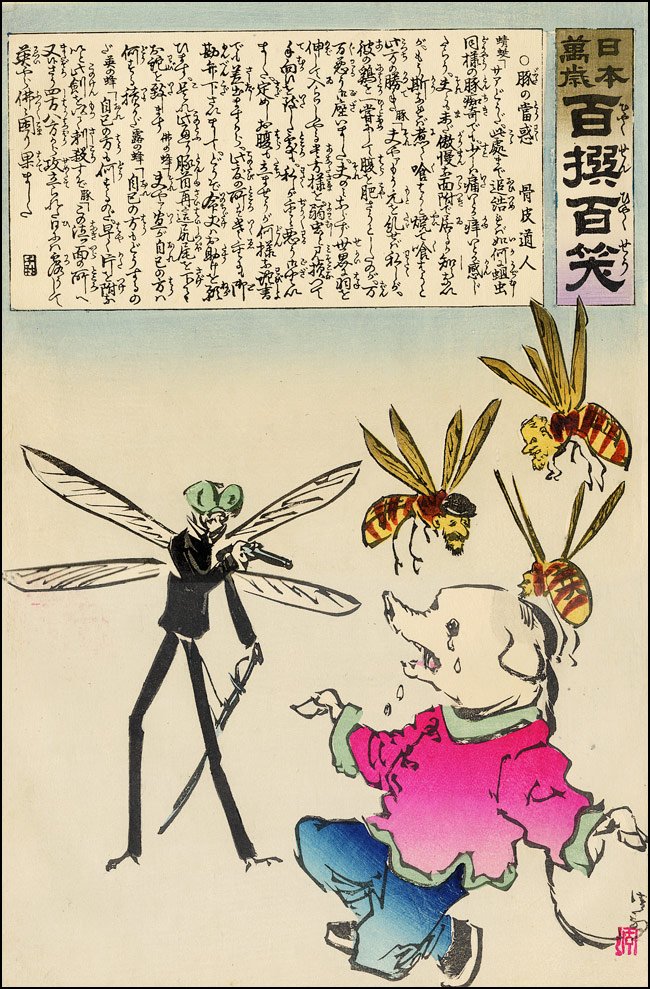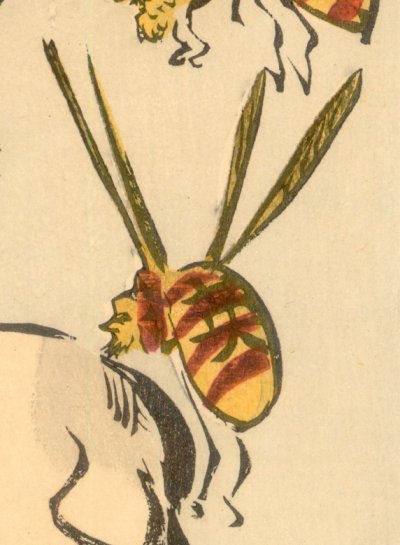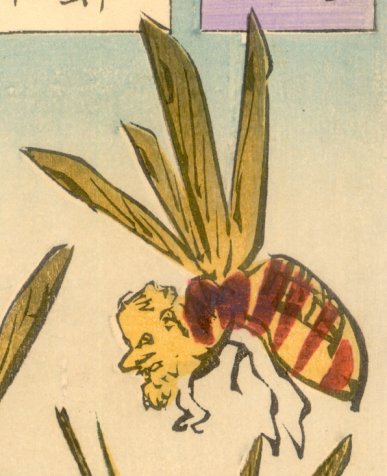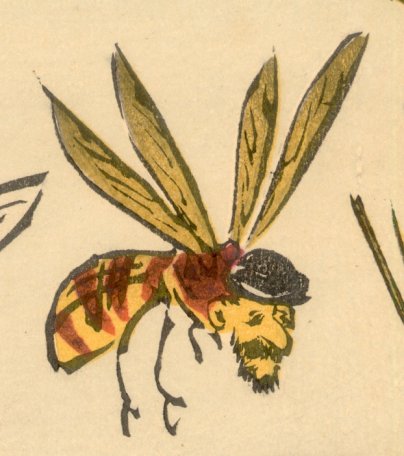
JAPANESE PRINTS
A MILLION QUESTIONS
TWO MILLION MYSTERIES
Ukiyo-e Prints浮世絵版画 |
|
formerly Port Townsend, Washington now Kansas City, Missouri |
Kobayashi Kiyochika
小林清親
こばやしきよちか
1847-1915
Series:
Long Live Japan - 100 Victories, 100 Laughs
日本萬歳 - 百撰百笑
Publisher:
Although trimmed it is most probably
Matsuki Heikichi
Date: 1894-5
Condition:
Slightly trimmed with Japanese album backing.
Good color.
Price: $105.00
Note: There are other copies of this print in the collections
of Waseda University, the Library of Congress. the Princeton University Art Museum
and
![]() the Ístasiatiska Museet,
Stockholm.
the Ístasiatiska Museet,
Stockholm.
SOLD!

For the significance of the dragonfly or tombo representing Japan
go to our Tengu thru Tombo index/glossary page.
|
"During the war with China, as throughout most of his career, Kiyochika revealed two faces, one lyrical and one comic. The lyric impulse during this period was reserved for the triptych format, while the comic spirit found expression in a series of single-sheet color woodblocks entitled 'One Hundred Victories, One Hundred Laughs' (Hyakusen hyakushō). The publisher was Matsuki Heikichi, who was also responsible for the majority of Kiyochika's war triptychs.
The series appeared in two parts, with different prefixes to the main title. First came 'Long Live Japan: One Hundred Victories, One Hundred Laughs,' a total of fifty sheets that appeared from as early as October 1894 and on into the late spring of 1895. At this point a table of contents was issued listing the first fifty prints and announcing a change in the series title to 'Magic Lantern of Society: One Hundred Victories, One Hundred Laughs,' thus marking the end of the war. The series continued on into early 1896, although it is doubtful that the second set of fifty was ever completed."
Note: The title 'Hyakussen hyakushō' is a pun on the homonyms that can be read either as "One Hundred Selections, One Hundred Laughs" or as "One Hundred Battles, One Hundred Victories," a common phrase at that time. |
Each of three threatening wasps represents a Western power.
The one closest to the head of the Chinese 'pig' is England - 英.

The one furthest from the imploring head is Russia - 露, I think.

I am not sure, but I think the wasp with the Toulouse-Lautrec look
may represent France - 佛.

|
While researching another topic we ran across a rather odd poem which it would appear was written by Edwin Arnold (エドウィン・アーノルド: 1832-1904) even though he wrote that it was the translation of letter from a Japanese officer serving in Korea. But was it? Entitled A Japanese Soldier it was based on an event in the life - the death - of the bugler Shirakami Genjirō, a hero of the Sino-Japanese War. Actually many people wrote about him, but it is the Arnold poem which caught our attention - especially the first stanza and how it seems to relate to this print. The long braid on the sobbing Chinese 'pig'. Clearly the Japanese, like the British, felt an overwhelming sense of superiority. Below is the first stanza.
Shirikami Genjiro, Bugler in the Line! You shall let our Westerns know Why the kiku shine; Why the Sun-flag, gleaming Bright from field to field, Drives the Dragon, screaming Makes the Pig-tails yield.
It is the last line that gets us most. Also, the reference to kiku is to the Japanese flag. See our entry on hi-no-maru on our Hil thru Hor page.
One more thing: It was set to music by someone named B. J. F. Varenhorst. Imagine. |
